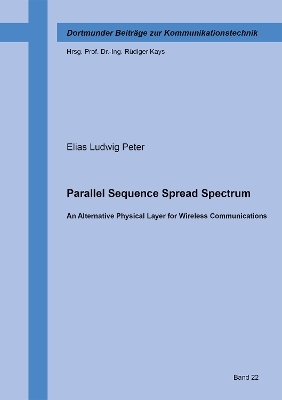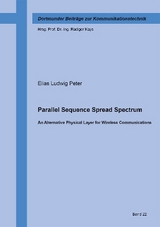Parallel Sequence Spread Spectrum
An Alternative Physical Layer for Wireless Communications
Seiten
Parallel Sequence Spread Spectrum (PSSS) is a novel code multiplexing technique based on superimposed spreading sequences to transmit data in parallel, using only a single carrier. It offers a flexible resource allocation, by sharing the available spectrum between a set of synchronous, cyclic codes with minimal interference and is therefore considered an alternative to orthogonal frequency-division multiplexing (OFDM). As a spread spectrum method, it has the potential to adapt to changing transmission conditions and specific applications.
The fundamentals of the PSSS method are examined from the ground up. The initially non-orthogonal, bipolar m-sequences used in PSSS are adjusted for orthogonality. This enables complex higher order modulation in a PSSS system. The characteristics of the pulse-shaped transmit signal and the influence of a nonlinear amplifier are studied. Novel synchronization concepts for PSSS are developed, including a PSSS-based preamble as well as methods using pilot codes. In the context of industrial wireless, different channel models are compared for their suitability to the application scenario of industrial PSSS.
Using representative channel impulse responses, the performance of different equalization techniques is compared through simulations. For the first time, the potential of a maximum likelihood sequence estimation in combination with PSSS is explored. The necessity of a cyclic prefix, as specified in the original PSSS design, is called into question and alternative more efficient physical layer designs are provided. Through measurements and simulations, the method is compared with the more common OFDM method, using suitable system parameters, demonstrating the potential of the PSSS approach for future wireless communications.
The fundamentals of the PSSS method are examined from the ground up. The initially non-orthogonal, bipolar m-sequences used in PSSS are adjusted for orthogonality. This enables complex higher order modulation in a PSSS system. The characteristics of the pulse-shaped transmit signal and the influence of a nonlinear amplifier are studied. Novel synchronization concepts for PSSS are developed, including a PSSS-based preamble as well as methods using pilot codes. In the context of industrial wireless, different channel models are compared for their suitability to the application scenario of industrial PSSS.
Using representative channel impulse responses, the performance of different equalization techniques is compared through simulations. For the first time, the potential of a maximum likelihood sequence estimation in combination with PSSS is explored. The necessity of a cyclic prefix, as specified in the original PSSS design, is called into question and alternative more efficient physical layer designs are provided. Through measurements and simulations, the method is compared with the more common OFDM method, using suitable system parameters, demonstrating the potential of the PSSS approach for future wireless communications.
| Erscheinungsdatum | 03.03.2024 |
|---|---|
| Reihe/Serie | Dortmunder Beiträge zur Kommunikationstechnik ; 22 |
| Verlagsort | Düren |
| Sprache | englisch |
| Maße | 148 x 210 mm |
| Gewicht | 324 g |
| Themenwelt | Technik ► Elektrotechnik / Energietechnik |
| Technik ► Nachrichtentechnik | |
| Schlagworte | Funk • Kommunikationstechnik • Nachrichtentechnik • Spread Spectrum • Übertragungstechnik |
| ISBN-10 | 3-8440-9398-2 / 3844093982 |
| ISBN-13 | 978-3-8440-9398-8 / 9783844093988 |
| Zustand | Neuware |
| Haben Sie eine Frage zum Produkt? |
Mehr entdecken
aus dem Bereich
aus dem Bereich
Technologie – Berechnung – Klimaschutz
Buch | Hardcover (2023)
Hanser (Verlag)
39,99 €




